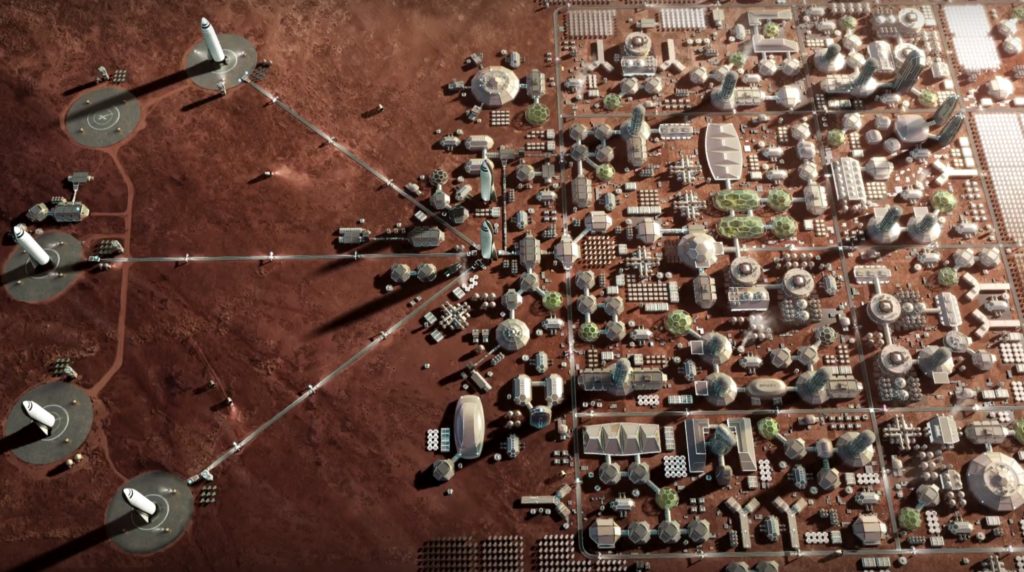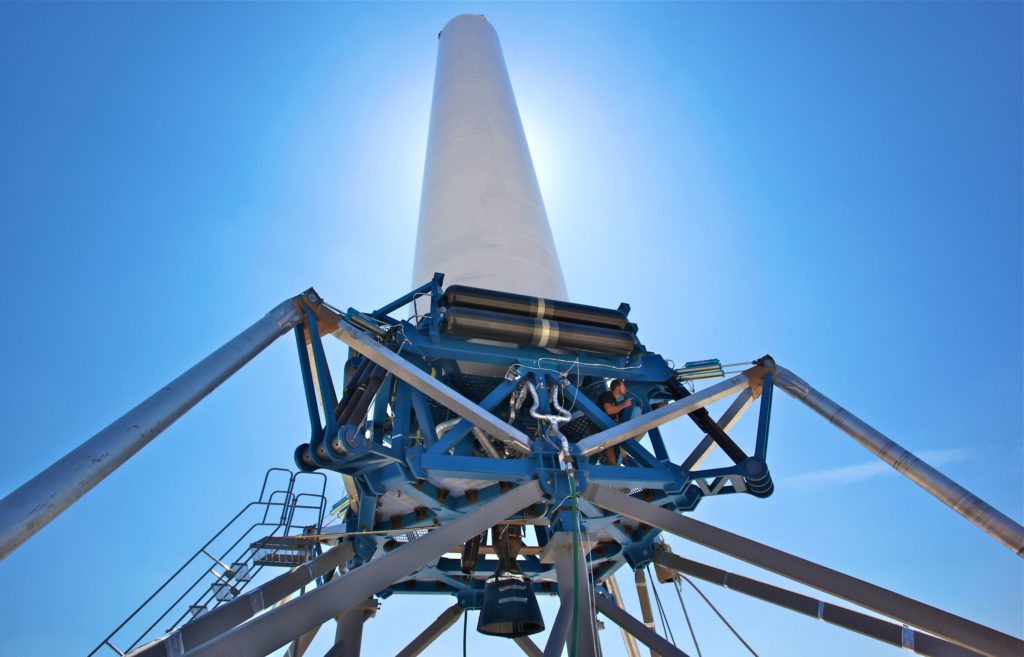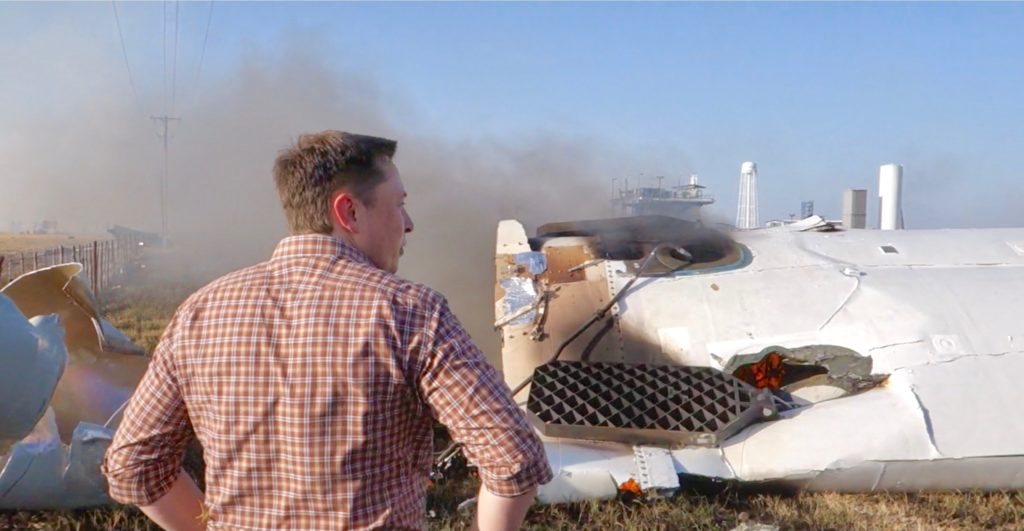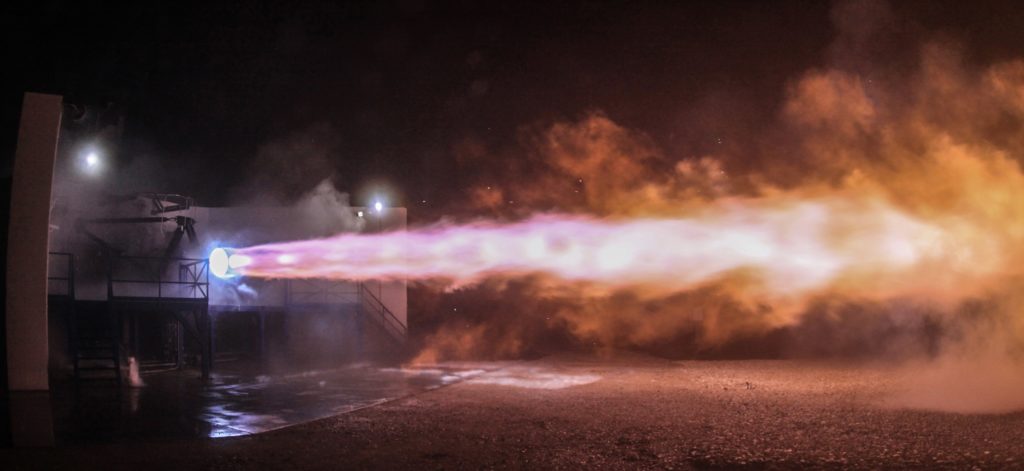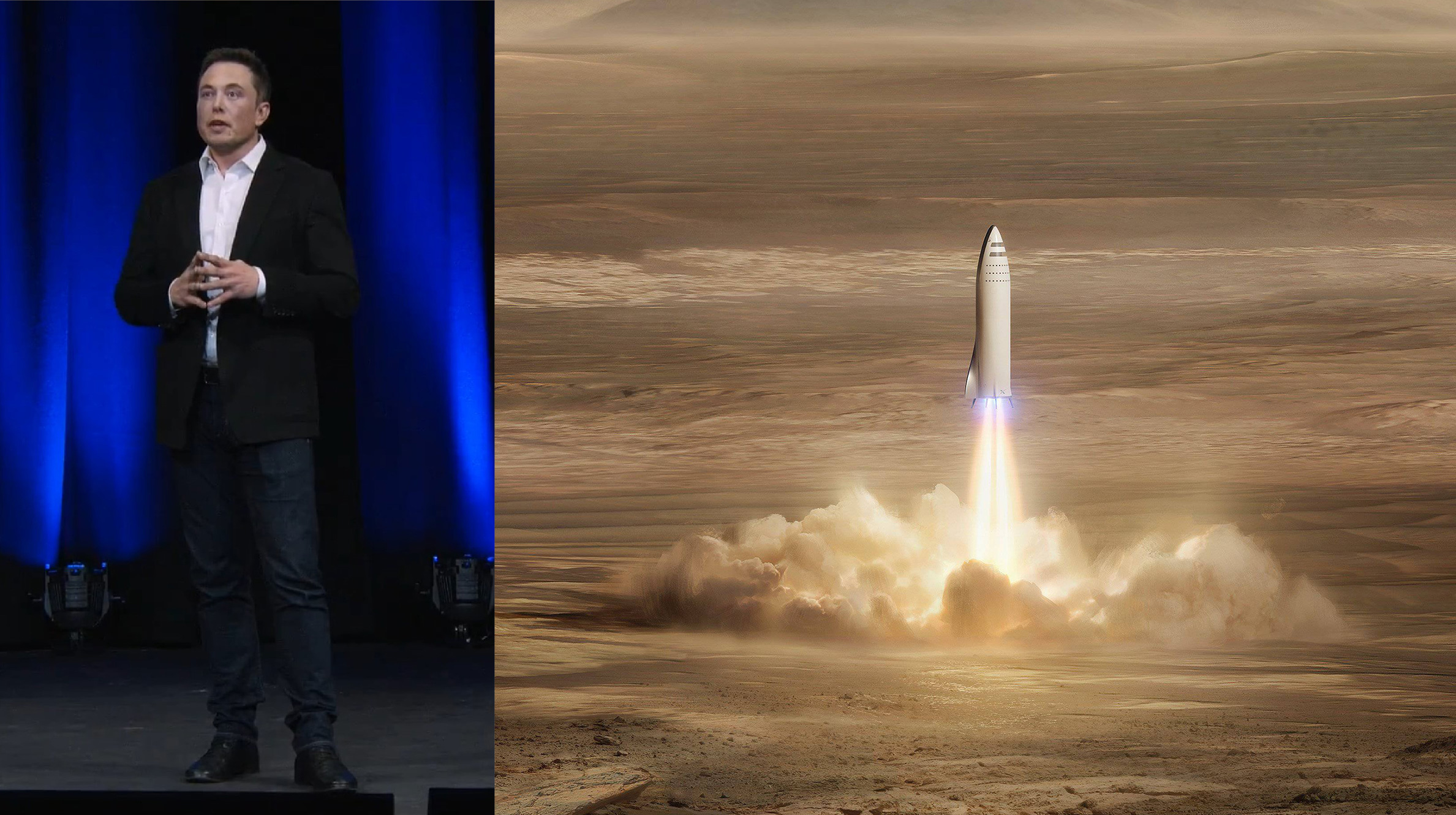

News
Elon Musk’s SpaceX AMA: Living on Mars, Spaceship Info, Timeline
SpaceX CEO Elon Musk hosted a Reddit AMA (Ask Me Anything) earlier this afternoon and spent several hours drinking whiskey, trolling the audience, answering some great questions, and generally having a blast. He revealed a vast array of fascinating new details about SpaceX’s giant new rocket (BFR), its upper stage spaceship (BFS), and much more.
All of Musk’s answers from the AMA have been collated and organized by category below. You’ll want to shy away from the AMA page itself, currently clocking in at more 10,000 comments.
When useful, particularly dense and technical responses have been summarized in italics for a broader audience.
Living on Mars
Q: Obviously there will be an extreme amount of care put into what is sent on the first missions, and the obvious answer of “Solar Panels” and “Fuel Production Equipment” is included, but what else?
A (Elon): Our goal is get you there and ensure the basic infrastructure for propellant production and survival is in place. A rough analogy is that we are trying to build the equivalent of the transcontinental railway. A vast amount of industry will need to be built on Mars by many other companies and millions of people.
Q: Does your Mars city feature permanently anchored BFS spaceships?
A (Elon): Wouldn’t read too much into that illustration
Q: Have any candidate landing sites for the Mars base been identified?
A (Elon): Landing site needs to be low altitude to maximize aero braking, be close to ice for propellant production and not have giant boulders. Closer to the equator is better too for solar power production and not freezing your ass off.
Q: Who will design and build the ISRU system for the propellant depot, and how far along is it?
A (Elon): SpaceX. Design is pretty far along. It’s a key part of the whole system.
Without ISRU (In-Situ Resource Utilization), BFS is unlikely to ever be able to take humans to Mars affordably enough to enable large colonies. This news is thus of huge importance, and suggests that SpaceX will be able to focus on developing BFR and BFS near-term.

Another hypothetical SpaceX city on Mars. Bases will need to be located near water resources. (SpaceX)
SpaceX Big F** Spaceship (BFS)
Q: Will the BFS landing propellants have to be actively cooled on the long trip to Mars?
A (Elon): The main tanks will be vented to vacuum, the outside of the ship is well insulated (primarily for reentry heating) and the nose of the ship will be pointed mostly towards the sun, so very little heat is expected to reach the header tanks. That said, the propellant can be cooled either with a small amount of evaporation. Down the road, we might add a cryocooler.
A (Elon): exactly (while methane could be kept in its liquid form solely through high pressure storage, the pressures required are immense and would require tanks that would be far too heavy for a rocket’s second stage.
Cold liquid oxygen and methane will unavoidably warm up over time, eventually returning to their gaseous forms if allowed. SpaceX’s solution for BFS, which will spend several months between Earth and Mars, is to rely on the Ship’s already great insulation, as well as minimal evaporative cooling (similar to how swamp coolers work).
Q: Will the BFS heat shield be mounted on the skin, or embedded?
A (Elon): The heat shield plates will be mounted directly to the primary tank wall. That’s the most mass efficient way to go. Don’t want to build a box in box.

Dragon 2’s PICA-X heat shield can be seen on the right. BFS’s heat shield will be made of the same material, albeit on a much larger scale. (SpaceX)
Q: Can the BFS delta wings and heat shield be removed for deep space missions?
A (Elon): Wouldn’t call what BFS has a delta wing. It is quite small (and light) relative to the rest of the vehicle and is never actually used to generate lift in the way that an aircraft wing is used.
Its true purpose is to “balance out” the ship, ensuring that it doesn’t enter engines first from orbit (that would be really bad), and provide pitch and yaw control during reentry.
Q: Why is the 2017 BFS spaceship largely cylindrical?
A (Elon): Best mass ratio is achieved by not building a box in a box. The propellant tanks need to be cylindrical to be remotely mass efficient and they have to carry ascent load, so lowest mass solution is just to mount the heat shield plates directly to the tank wall.
For a rocket, mass ratio refers to its weight with a full load of propellant divided by its weight while completely empty. The lighter a rocket’s structure, the more mass it can lift into a given orbit.
- SpaceX’s conceptual Interplanetary Transport System from 2016 was considerably larger and more structurally complex than 2017’s BFR. (SpaceX)
- The relatively cylindrical BFS reduces complexity and lowers weight. (SpaceX)
Q: How does the BFS achieve vertical stabilization, without a tail?
A (Elon): Tails are lame
A (Elon): +1 (The space shuttle’s vertical stabilizer was completely useless for most of the reentry profile, as it was in complete aerodynamic shadow. I think it’s clear a craft doesn’t need one for reentry, only for subsonic gliding, which BFS doesn’t really do.)
BFS doesn’t need a tail because tails add weight, are of little use during orbital reentry, and BFS is not intended to glide.
Q: Why was the number of BFS landing legs increased from 3 to 4?
A (Elon): Because 4
A (Elon): Improves stability in rough terrain
Q: How is the radiation shielding in the ITS?
A (Elon): Ambient radiation damage is not significant for our transit times. Just need a solar storm shelter, which is a small part of the ship. Buzz Aldrin is 87.
While radiation fearmongers may balk at this statement, it is to some extent true. The risks from radiation (PDF) for a six month journey in deep space are approximately similar to several dozen CT scans, while two years spent on the surface of Mars with little to no shielding would result in about the same amount of exposure. Underground habitats could alleviate a considerable amount of the risk from living on Mars’ surface.
The issues and dangers posed by radiation ought not be trivialized but they can be dealt with, particularly if BFR can deliver massive payloads to the planet.
Q: Why was the location and shape of the BFS header/landing tanks changed?
A (Elon): The aspiration by the change was to avoid/minimize plumbing hell, but we don’t super love the current header tank/plumbing design. Further refinement is likely.
Header tanks refer to smaller tanks contained within the main propellant tanks that are used to ignite engines in microgravity. It’s easier to pressurize or simply fill the smaller tanks than it is to do so with the massive main tanks.
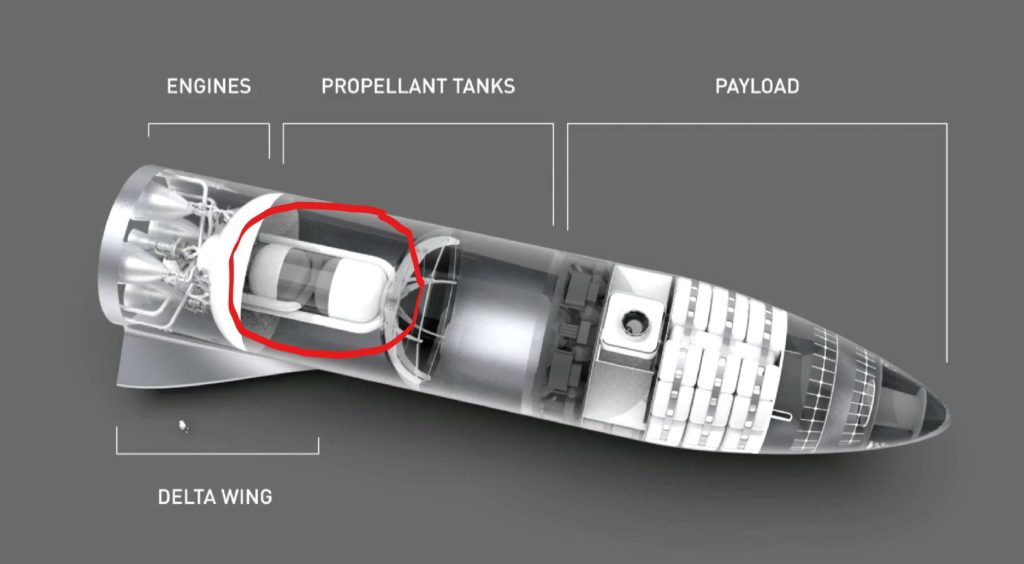
BFS’ header tanks circled in red. (SpaceX)
BFS Tanker
Q: Will the BFS tanker’s payload section be empty, or include extra propellant tanks?
A (Elon): At first, the tanker will just be a ship with no payload. Down the road, we will build a dedicated tanker that will have an extremely high full to empty mass ratio (warning: it will look kinda weird).
Using one version of the BFS as both a tanker and ship will streamline the initial development process for the rocket.

Two Spaceships docked for refuelling. (SpaceX)
Q: Will the BFS tanker ships (have to) do a hoverslam landing?
A (Elon): Landing will not be a hoverslam, depending on what you mean by the “slam” part. Thrust to weight of 1.3 will feel quite gentle. The tanker will only feel the 0.3 part, as gravity cancels out the 1. Launch is also around 1.3 T/W, so it will look pretty much like a launch in reverse….
BFS will land relatively gently, and BFR’s liftoff will also be gentle.
Development schedule
Q: With the first two cargo missions scheduled to land on Mars in 2022, what kind of development progress can we expect to see from SpaceX in the next 5 or so years leading up to the maiden flight?
Will we see BFS hops or smaller test vehicles similar to Grasshopper/F9R-Dev? Facilities being built? Propellant plant testing? etc. etc.
A (Elon): A lot. Yes, yes, and yes.
A (Elon): Will be starting with a full-scale Ship doing short hops of a few hundred kilometers altitude and lateral distance. Those are fairly easy on the vehicle, as no heat shield is needed, we can have a large amount of reserve propellant and don’t need the high area ratio, deep space Raptor engines.
Next step will be doing orbital velocity Ship flights, which will need all of the above. Worth noting that BFS is capable of reaching orbit by itself with low payload, but having the BF Booster increases payload by more than an order of magnitude. Earth is the wrong planet for single stage to orbit. No problemo on Mars.
The first real tests of the BFR will be done by hopping a full-scale BFS “several hundred kilometers”. BFS is capable of launching itself and a tiny payload into orbit, but the utility is limited on Earth. On Mars, BFS will be far more capable as a single stage to orbit (SSTO) launch vehicle.
- F9R-dev, used to test vertical take off and landing for Falcon 9. BFR will go through a similar program with its spaceship upper stage prior to orbital missions. (Steve Jurvetson)
- F9R sadly suffered a software bug and self-destructed in 2014, but SpaceX had already learned most of what it needed to begin Falcon 9 recoveries. (Steve Jurvetson)
Raptor and rocket propulsion
Q: Why was Raptor thrust reduced from ~300 tons-force to ~170 tons-force?
A (Elon): We chickened out. The engine thrust dropped roughly in proportion to the vehicle mass reduction from the first IAC talk. In order to be able to land the BF Ship with an engine failure at the worst possible moment, you have to have multiple engines. The difficulty of deep throttling an engine increases in a non-linear way, so 2:1 is fairly easy, but a deep 5:1 is very hard. Granularity is also a big factor. If you just have two engines that do everything, the engine complexity is much higher and, if one fails, you’ve lost half your power. Btw, we modified the BFS design since IAC to add a third medium area ratio Raptor engine partly for that reason (lose only 1/3 thrust in engine out) and allow landings with higher payload mass for the Earth to Earth transport function.
The Raptor engine’s maximum thrust has been decreased mainly because the size of the rocket decreased, from 12m to 9m in diameter. For redundancy’s sake, SpaceX has added a third central engine to the spaceship, versus the two engines mentioned at the 2017 IAC.
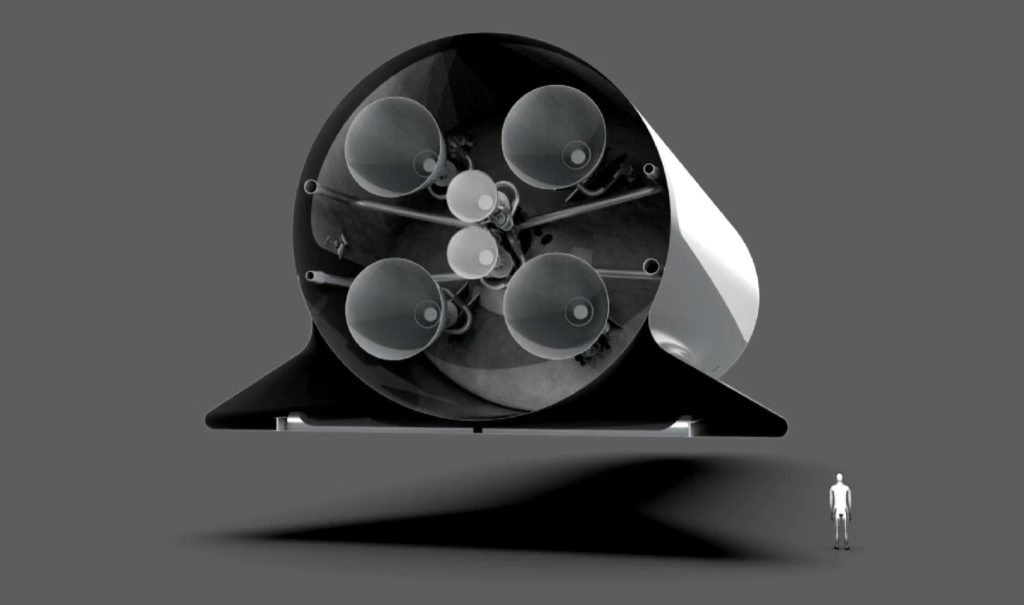
BFS’ delta “wings” from the rear of the ship. Also shown are the Raptors, with the two in the center now reportedly expanded to three engines. (SpaceX)
Q: Will the BFR autogenous pressurization system be heat exchanger based?
A (Elon): We plan to use the Incendio spell from Harry Potter
A (Elon): But, yes and probably
Autogenous pressurization refers to the method of propellant tank pressurization used. In microgravity conditions, tanks must be pressurized to keep fuel flowing to the engines and to improve the density of the fuel. While Falcon 9 currently uses high-pressure helium, ITS and now BFR have been designed to use the actual propellant in their tanks (methane and oxygen) for pressurization. This reduces the number of failure modes on BFR and improves the spaceship’s payload capabilities.
Q: Will the BFS methalox control thrusters be derived from Raptor or from SuperDraco engines?
A (Elon): The control thrusters will be closer in design to the Raptor main chamber than SuperDraco and will be pressure-fed to enable lowest possible impulse bit (no turbopump spin delay).
Like Falcon 9, BFR will need gas thrusters (RCS, reaction control system) to control its orientation (and refuel) while in microgravity conditions. While Falcon uses cold nitrogen gas thrusters, BFR will utilize the propellant it is already carrying for Raptor, methane and oxygen. Again, the goal of this is to reduce complexity.
Q: Could you update us on the status of scaling up the Raptor prototype to the final size?
A (Elon): Thrust scaling is the easy part. Very simple to scale the dev Raptor to 170 tons.
The flight engine design is much lighter and tighter, and is extremely focused on reliability. The objective is to meet or exceed passenger airline levels of safety. If our engine is even close to a jet engine in reliability, has a flak shield to protect against a rapid unscheduled disassembly and we have more engines than the typical two of most airliners, then exceeding airline safety should be possible.
That will be especially important for point to point journeys on Earth. The advantage of getting somewhere in 30 mins by rocket instead of 15 hours by plane will be negatively affected if “but also, you might die” is on the ticket.
SpaceX’s subscale Raptor, the one seen in videos and photos of it firing, is understood to be a bit more than half the size of the operational engine described at IAC 2017. Increasing the scale of the engine is not the difficult aspect of development. Rather, optimization, weight reduction, and extreme reusability are the main sources of difficulty needed before Raptor is flight-ready. This reusability is central to the goal of reliable and rapid reuse of orbital-class rockets.
- SpaceX revealed this stunning photo of Raptor’s first (partial) hot-fire test the night before Musk’s talk at Guadalajara. (SpaceX)
- SpaceX’s subscale Raptor engine has completed more than 1200 seconds of testing in less than two years. (SpaceX)
Q: Can BFS vacuum-Raptors be fired at sea level pressure?
A: The “vacuum” or high area ratio Raptors can operate at full thrust at sea level. Not recommended.
Put simply, vacuum nozzles do not like to operate in an atmosphere.
Mars communications
Q: Does SpaceX have any interest in putting more satellites in orbit around Mars (or even rockets) for internet/communications before we get feet on the ground? Or are the current 5-6 active ones we have there sufficient?
A (Elon): Yes
Q: Also will there be some form of an internet or communications link with Earth? Is SpaceX going to be in charge of putting this in or are you contracting some other companies?
A (Elon): If anyone wants to build a high bandwidth comm link to Mars, please do.
Taken side by side, this likely indicates that SpaceX will develop a high-bandwidth Mars-Earth communications link if nobody else does, but that they would logical prefer that someone else builds that infrastructure beforehand.
Q: The concept of an internet connection on Mars is kinda awesome. You could theoretically make an internet protocol that would mirror a subset of the internet near Mars. A user would need to queue up the parts of the internet they wanted available and the servers would sync the relevant data.
A (Elon): Nerd
A (Elon): But, yes, it would make sense to strip the headers out and do a UDP-style feed with extreme compression and a CRC check to confirm the packet is good, then do a batch resend of the CRC-failed packets. Something like that. Earth to Mars is over 22 light-minutes at max distance.
A (Elon): 3 light-minutes at closest distance. So you could Snapchat, I suppose. If that’s a thing in the future.
The communication delay between Earth and Mars (at least several minutes one-way) will prevent any Martian habitats from simply integrating with Earth’s Internet. The delay will require some sort of mediation. As an example, a user on Mars could select the websites they want to browse or videos they want to watch beforehand, and they would be available between several minutes and an hour later.

SpaceX’s Starlink satellite constellation efforts could provide the company with valuable experience that can be applied around Mars. (unofficial logo by Eric Ralph)
Boring!
Q: Boring question about Mars:
A (Elon): More boring!
Miscellaneous silliness
Q: This is one bizarre AMA so far…
A (Elon): Just wait…
Q: i feel like thats a threat. “just wait. it will get way more bizarre than that. let me finish my whiskey”
A (Elon): How did you know? I am actually drinking whiskey right now. Really.
…No comment…
All things considered, this was a wildly successful AMA. Elon clearly had a whole lot of fun, the audience got lightheartedly trolled, and SpaceX fans will undoubtedly be chewing over the technical details he elucidated for weeks to come. Special thanks are owed to the subreddit /r/SpaceX and user /u/_Rocket_, who together managed to flood the AMA with an array of intelligent, pointed, and reasonable questions, at least ten of which were answered by Musk.

Elon Musk
SpaceX issues statement on Starship V3 Booster 18 anomaly
The incident unfolded during gas-system pressure testing at the company’s Massey facility in Starbase, Texas.

SpaceX has issued an initial statement about Starship Booster 18’s anomaly early Friday. The incident unfolded during gas-system pressure testing at the company’s Massey facility in Starbase, Texas.
SpaceX’s initial comment
As per SpaceX in a post on its official account on social media platform X, Booster 18 was undergoing gas system pressure tests when the anomaly happened. Despite the nature of the incident, the company emphasized that no propellant was loaded, no engines were installed, and personnel were kept at a safe distance from the booster, resulting in zero injuries.
“Booster 18 suffered an anomaly during gas system pressure testing that we were conducting in advance of structural proof testing. No propellant was on the vehicle, and engines were not yet installed. The teams need time to investigate before we are confident of the cause. No one was injured as we maintain a safe distance for personnel during this type of testing. The site remains clear and we are working plans to safely reenter the site,” SpaceX wrote in its post on X.
Incident and aftermath
Livestream footage from LabPadre showed Booster 18’s lower half crumpling around the liquid oxygen tank area at approximately 4:04 a.m. CT. Subsequent images posted by on-site observers revealed extensive deformation across the booster’s lower structure. Needless to say, spaceflight observers have noted that Booster 18 would likely be a complete loss due to its anomaly.
Booster 18 had rolled out only a day earlier and was one of the first vehicles in the Starship V3 program. The V3 series incorporates structural reinforcements and reliability upgrades intended to prepare Starship for rapid-reuse testing and eventual tower-catch operations. Elon Musk has been optimistic about Starship V3, previously noting on X that the spacecraft might be able to complete initial missions to Mars.
Investor's Corner
Tesla analyst maintains $500 PT, says FSD drives better than humans now
The team also met with Tesla leaders for more than an hour to discuss autonomy, chip development, and upcoming deployment plans.

Tesla (NASDAQ:TSLA) received fresh support from Piper Sandler this week after analysts toured the Fremont Factory and tested the company’s latest Full Self-Driving software. The firm reaffirmed its $500 price target, stating that FSD V14 delivered a notably smooth robotaxi demonstration and may already perform at levels comparable to, if not better than, average human drivers.
The team also met with Tesla leaders for more than an hour to discuss autonomy, chip development, and upcoming deployment plans.
Analysts highlight autonomy progress
During more than 75 minutes of focused discussions, analysts reportedly focused on FSD v14’s updates. Piper Sandler’s team pointed to meaningful strides in perception, object handling, and overall ride smoothness during the robotaxi demo.
The visit also included discussions on updates to Tesla’s in-house chip initiatives, its Optimus program, and the growth of the company’s battery storage business. Analysts noted that Tesla continues refining cost structures and capital expenditure expectations, which are key elements in future margin recovery, as noted in a Yahoo Finance report.
Analyst Alexander Potter noted that “we think FSD is a truly impressive product that is (probably) already better at driving than the average American.” This conclusion was strengthened by what he described as a “flawless robotaxi ride to the hotel.”
Street targets diverge on TSLA
While Piper Sandler stands by its $500 target, it is not the highest estimate on the Street. Wedbush, for one, has a $600 per share price target for TSLA stock.
Other institutions have also weighed in on TSLA stock as of late. HSBC reiterated a Reduce rating with a $131 target, citing a gap between earnings fundamentals and the company’s market value. By contrast, TD Cowen maintained a Buy rating and a $509 target, pointing to strong autonomous driving demonstrations in Austin and the pace of software-driven improvements.
Stifel analysts also lifted their price target for Tesla to $508 per share over the company’s ongoing robotaxi and FSD programs.
Elon Musk
SpaceX Starship Version 3 booster crumples in early testing
Photos of the incident’s aftermath suggest that Booster 18 will likely be retired.

SpaceX’s new Starship first-stage booster, Booster 18, suffered major damage early Friday during its first round of testing in Starbase, Texas, just one day after rolling out of the factory.
Based on videos of the incident, the lower section of the rocket booster appeared to crumple during a pressurization test. Photos of the incident’s aftermath suggest that Booster 18 will likely be retired.
Booster test failure
SpaceX began structural and propellant-system verification tests on Booster 18 Thursday night at the Massey’s Test Site, only a few miles from Starbase’s production facilities, as noted in an Ars Technica report. At 4:04 a.m. CT on Friday, a livestream from LabPadre Space captured the booster’s lower half experiencing a sudden destructive event around its liquid oxygen tank section. Post-incident images, shared on X by @StarshipGazer, showed notable deformation in the booster’s lower structure.
Neither SpaceX nor Elon Musk had commented as of Friday morning, but the vehicle’s condition suggests it is likely a complete loss. This is quite unfortunate, as Booster 18 is already part of the Starship V3 program, which includes design fixes and upgrades intended to improve reliability. While SpaceX maintains a rather rapid Starship production line in Starbase, Booster 18 was generally expected to validate the improvements implemented in the V3 program.
Tight deadlines
SpaceX needs Starship boosters and upper stages to begin demonstrating rapid reuse, tower catches, and early operational Starlink missions over the next two years. More critically, NASA’s Artemis program depends on an on-orbit refueling test in the second half of 2026, a requirement for the vehicle’s expected crewed lunar landing around 2028.
While SpaceX is known for diagnosing failures quickly and returning to testing at unmatched speed, losing the newest-generation booster at the very start of its campaign highlights the immense challenge involved in scaling Starship into a reliable, high-cadence launch system. SpaceX, however, is known for getting things done quickly, so it would not be a surprise if the company manages to figure out what happened to Booster 18 in the near future.
